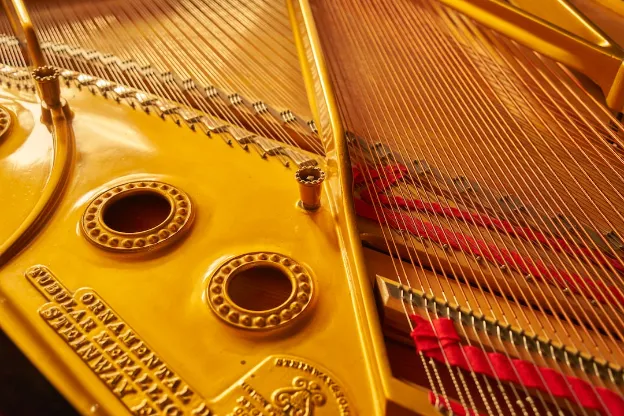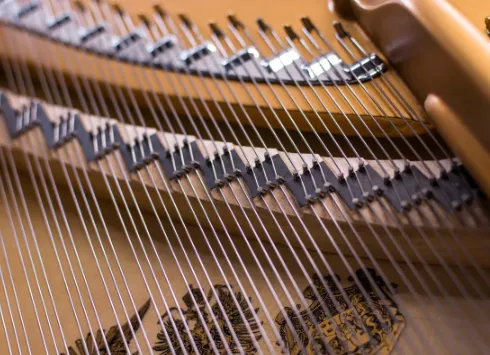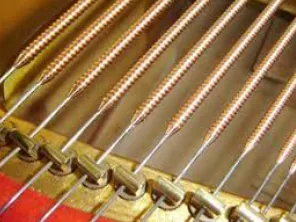How Many Strings Does A Grand Piano Have And Why

-
How many strings does an acoustic piano have?
-
Is there 1 string per key on a piano? 2 strings per key? Or 3 strings per key?
-
Which sections contain the most number of strings on a piano?
-
What are the pair of 2 bass strings called on a piano?
-
Why are there 3 strings per note in the treble section of a piano?
-
The length of the string
-
Gauge Thickness
-
Strings per note
-
Do Pianos ever have 4 strings per note?
-
What’s the tension on piano strings?
How many strings does an acoustic piano have?
There are roughly 230 piano strings and tuning pins in modern pianos (baby grand, grand pianos, and vertical pianos) with just 88 number of keys.
While it may seem like such an unusual number, the inner workings of a piano requires specific volume and tonal needs, which lead to this number of piano strings in acoustic pianos.
Thanks to the cast iron frame it has made it possible for a string instrument to hold 18 tons of tension from all of the strings of the piano, which is just over 150 pounds of tension per string.
In this article we will explore why piano makers chose 230 strings in all types of pianos, where they are all located, and why there are differing numbers of string for each key on the piano.
Is there 1 string per key on a piano? 2 strings per key? Or 3 strings per key?
The answer is a mix of all of the above, but the more useful question is in which sections have more strings than others and why?
It doesn’t matter so much if they are white keys or black keys, but it matters whether they are lower notes or higher notes.
I will explain below the reasons why design choices were made to justify the number of strings for each and every single note of a section.
Which sections contain the most number of strings on a piano?
Mid Range & High Treble
The mid range and high treble have 198 strings per 66 keys, which comes out to be 3 strings per note.
The midrange is where the copper windings are no longer included and where all 3 steel strings per 1 piano key come together to make a tone for each note.
When the 3 tones of the solid steel strings together to sound at one single pitch, this is called the “unison.”
Since these strings gradually become a smaller gauge of wire, it is necessary to have 3 strings per note so that each note can have more volume of sound because they are thinner strings.
It doesn’t help that as the thickness of the wire shrinks the length of the strings also shrinks which is all the more reason why there must be a greater number of strings to compensate for less volume.
Low Bass Section
In general, in the low bass section there are respectively 12 strings per 12 keys.
The 12 lowest notes in the low bass section contain fewer strings than just about any other section on the piano. Strings per note decreases as the pitch goes lower down the piano because the thickness of the string (and length of strings) changes.
The reason for this is that the steel wire strings have copper wire wound around the strings to add more mass which means additional tone quality with the extra strings.
The added mass of the string weighs more so that the frequency of the string is slowed down causing the pitch to be lower when the hammer shank hits the string.
A single string of greater mass in the bass section sounds much more substantial compared with a single string in the higher notes.
This is because the higher notes have shorter strings with less mass per string comparatively.
As we will explore in other sections, additional strings are necessary to make up for tone quality to ensure the sound is sufficiently robust in the high treble section.
Bass Break Section
Above the lowest bass notes is the “bass break” section which has 2 strings for every 1 single key.
What are the pair of 2 bass strings called on a piano?
These strings are called “bi-chords.”
There are roughly 10 keys in the bass break section that have 2 strings per 1 note which means there are 20 strings per 10 keys in this section.
These bass strings are also wound with copper windings to add mass to the string just like in the low bass section.
If there are 12 strings in the low bass section for 12 keys and there are 20 strings per 10 keys in the bass break section, that adds up to 52 strings that we have accounted for in these two sections for the first 22 keys of the piano.
In the next 66 piano notes we will add up to a total of 230 strings.
Why are there 3 strings per note in the treble section of a piano?
Tone Quality.
In order to get the best sound out of a piano one must consider factors such as the length of the string, the gauge thickness of the string, and how many strings should be included in each note over the entire piano.
The length of the string
This primarily effects the potential pitch of the string and is determined through the lens of what is commonly referred to by your piano technician as the “scale design” of the piano, which directly impacts the tonal quality of the piano.
The length of the piano is an easy way to tell if the strings are capable of a high tonal quality which is the bedrock of the source of the sound.
Gauge Thickness
The lowest string has the greatest thickness in any grand piano or upright pianos.
Due to added mass/thickness, the pitch of the note is lower while also adding to the tonal quality of a piano and volume to the bass section which requires less strings.
As mass is decreased from a given string, the pitch increases and the tonal depth decreases.
As tonal depth decreases per string moving upwards on the piano, additional strings are added to the piano for additional reverberation of the strings.
Strings per note
Treble notes of a Bluthner (4 strings per note)
Do Pianos ever have 4 strings per note?
^^^ The Bluthner is one of the only pianos that has a 4th string per note, specifically for high pitch notes. (Pictured Above)
The lowest of low notes in the bass section only have 1 string per note because the extra thick strings are plenty loud which makes it unnecessary to have more than 1 string for roughly a dozen notes in that section.
Additional strings are added to the “bass break” section to 2 strings per note to increase the tonal quality and volume of the notes since the mass of the string decreases as the string gets shorter and thinner.
Going upwards on the piano, the copper winding is thinner to allow for higher and higher pitch going up the instrument.
When going further up the piano, eventually the copper windings are no longer applied, moreover, a third additional string is added so as to increase the tonal quality and volume of the higher notes.
In Summary…
1 thick string per note in the low bass section
2 Medium thick strings per note in the upper bass section
3 thin strings per note going up from there.
*Surprisingly enough, on occasion I get asked whether digital pianos have strings and I must inform clients that they do not in fact, have strings. :)
String tension
What’s the tension on piano strings?
A fun fact about string tension is that the tension of the strings is remarkably close across all of the strings.
It's the length of the string, the gauge of the string, and additional copper mass that influence the pitch of the string more than the differences in high tension.
Whether it be a single string on the lowest note or 1 of 3 strings on the highest note, there is roughly between 150-200 pounds of tension on each one of the strings.
Yamaha Piano Reviews
Bechstein Piano Reviews
Korg Keyboard Reviews
-
How many strings does an acoustic piano have?
-
Is there 1 string per key on a piano? 2 strings per key? Or 3 strings per key?
-
Which sections contain the most number of strings on a piano?
-
What are the pair of 2 bass strings called on a piano?
-
Why are there 3 strings per note in the treble section of a piano?
-
The length of the string
-
Gauge Thickness
-
Strings per note
-
Do Pianos ever have 4 strings per note?
-
What’s the tension on piano strings?







